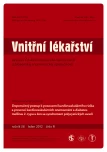Septic shock due to infective endocarditis of stimulation system of implantable cardioverter-defibrillator
Authors:
I. Porubčinová 1; Š. Porubčin 2; B. Stančák 3; M. Beňa 1; F. Sabol 1
Authors‘ workplace:
Klinika srdcovej chirurgie, VUSCH a. s., Košice, prednosta MUDr. F. Sabol
1; Klinika infektológie a cestovnej medicíny, UNLP, Košice, prednosta prof. MUDr. I. Schréter, CSc.
2; Klinika kardiológie – arytmologické oddelenie VUSCH a. s., Košice, prednosta doc. B. Stančák, CSc. .
3
Published in:
Vnitř Lék 2012; 58(1): 58-61
Category:
Case Reports
Overview
We present a case of a 60-year old patient hospitalized at the Department of Infectious Diseases and Travel Medicine, Medical faculty of UPJS and L. Pasteur‘s University Hospital in Kosice with suspected gastroenteritis. The patient was admitted to an intensive care unit because of the signs of septic shock. Within one hour from admission, the patient was administered early goal directed therapy for septic shock. Subsequently, infectious endocarditis of stimulation electrodes and tricuspid valve was identified as the origin of the infection. The stimulation system was then explanted from a stabilized and afebrile patient at the Department of cardiac Surgery of Eastern Slovak Institute of Cardiac and Vascular Diseases in Kosice. This case should emphasise frequently atypical course of this serious disease and the need for early identification of severe sepsis to enable timely management to affect mortality.
Key words:
sepsis – infectious endocarditis – implantable cardioverter-defibrillator
Sources
1. Ellenbogen KA, Kay NG, Lau CP et al. Clinical cardiac pacing, defibrillation, and resynchronization therapy. 4th ed. Philadelphia: Saunders 2007.
2. Uslan DZ, Sohail MR, St Sauver JL et al. Permanent pacemaker and implantable cardioverter defibrillator infection: a population-based study. Arch Intern Med 2007; 167: 669–675.
3. Cacoub P, Leprince P, Nataf P et al. Pacemaker infective endocarditis. J Cardiol 1998; 82: 480–484.
4. Sohail MR, Uslan DZ, Khan AH et al. Infective endocarditis complicating permanent pacemaker and implantable cardioverter-defibrillator infection. Mayo Clin Proc 2008; 83: 46–53.
5. Habib G, Hoen B, Tornos P et al. Guidelines on the prevention, diagnosis, and treatment of infective endocarditis (new version 2009): the Task Force on the Prevention, Diagnosis, and Treatment of Infective Endocarditis of the European Society of Cardiology (ESC). Endorsed by the European Society of Clinical Microbiology and Infectious Diseases (ESCMID) and the International Society of Chemotherapy (ISC) for Infection and Cancer. Eur Heart J 2009; 30: 2369–2413.
6. Otto CH. The practice of clinical echocardiography. 3rd ed. Philadelphia: Saunders 2007: 502–511.
7. Dumont E, Camus C, Victor F et al. Suspected pacemaker or defibrillator transvenous lead infection. Prospective assessment of a TEE-guided therapeutic strategy. Eur Heart J 2003; 24: 1779–1787.
8. Villamil Cajoto I, Rodríguez Framil M, Van den Eynde Collado A et al. Permanent transvenous pacemaker infections: An analysis of 59 cases. Eur J Intern Med 2007; 18: 484–488.
9. Vlašínová J. Cardiac device-related infection – a new epidemic? Cor Vasa 2010; 52: 62–66.
10. Rivers E, Nguyen B, Havstad S et al. EGDT in the treatment of severe sepsis and septic shock. N Engl J Med 2001; 345: 1368–1377.
11. Rivers EP, Coba V, Whitmill M. Early goal-directed therapy in severe sepsis and septic shock: a contemporary review of the literature. Curr Opin Anesthesiol 2008; 21: 128–140.
12. Shorr AF, Micek ST, Jackson WL Jr et al. Economic implications of an evidence-based sepsis protocol: can we improve outcomes and lower costs? Crit Care Med 2007; 35: 1257–1262.
Labels
Diabetology Endocrinology Internal medicineArticle was published in
Internal Medicine

2012 Issue 1
Most read in this issue
- Endocrine changes in liver disease
- Hyponatraemia associated with the syndrome of inappropriate antidiuretic hormone hypersecretion (SIADH) – options for treatment
- A detailed study of colon polyps
- Hyponatremia – carbamazepine medication complications
